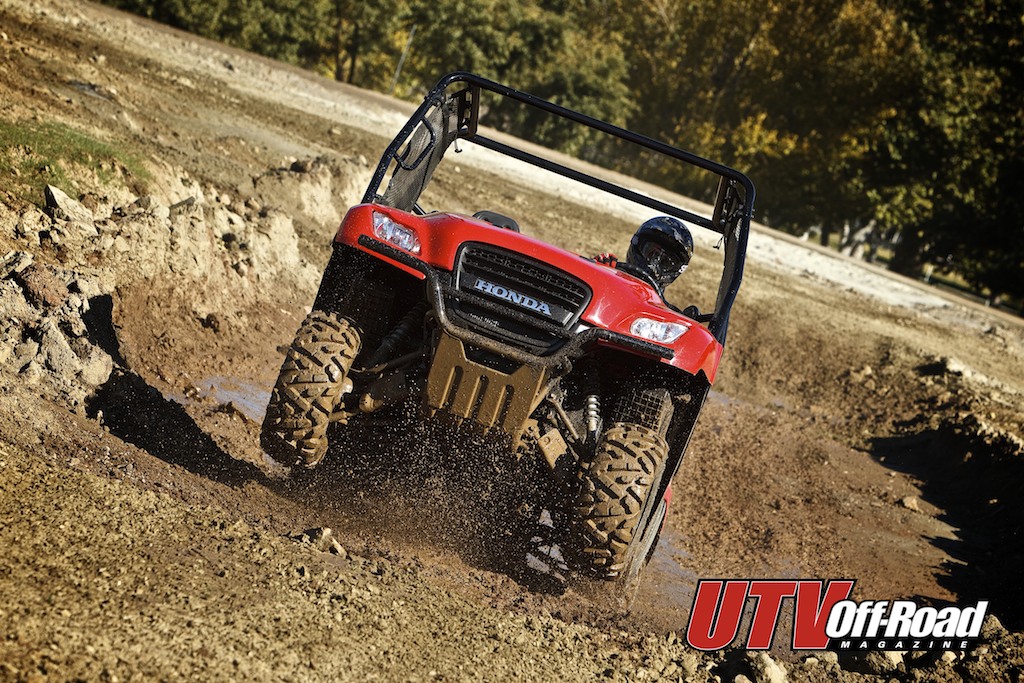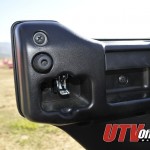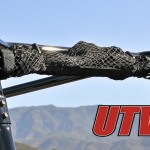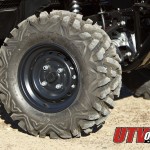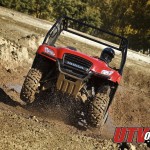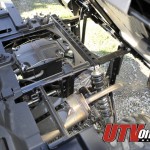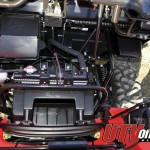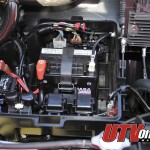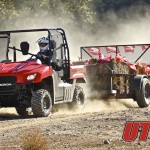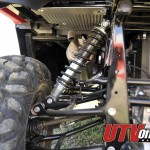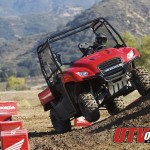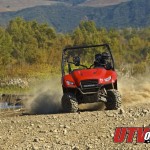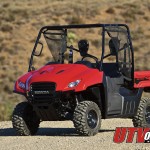2011 Honda Big Red MUV 700
For an OEM manufacturer, designing an all-new UTV is a bit of a daunting task. Concepts take a few years to half a decade to bring to fruition, and even after a new model is brought to market, many small tweaks and changes must be made to keep it competitive in the eye of the public. Honda is no exception to the rule. Despite their reputation for spot-on fit and finish, attention to detail, and practicality, the Big Red never made a huge splash in the UTV market. Overshadowed by the sales figures of the workhorses from Polaris and Yamaha, Honda went back to the drawing board to assess a few areas of concern that both the media and the paying public had brought to their attention. What was the result? A re-worked and refreshed version of the Big Red “MUV”, complete with double the hauling and more towing capacities of the outgoing version!
FUNCTION OVER FORM
One of the most apparent differences in the new Big Red’s cockpit layout is the bench seat- it replaces the two short buckets Honda originally designed for the BR. The dense foam seat pad has an adjustable backrest as well, which ups the comfort level significantly. Despite having a single bench seat, passenger capacity remains at two, and there is no center seat belt for a third. The parking brake handle has been relocated to the panel directly below the center section of the bench seat, and Honda claims it will hold the ‘Red at full capacity on a 35-degree incline. During the press introduction at Irvine Lake, California, we got the opportunity to test the brake’s holding power with a bed full (1000 lbs) of cargo- it didn’t budge a bit.
Getting in and out of the new bench seat is made easier via a new set of roll-up nets on either side of the cab. Quick release clips allow you to roll the nets up and out of the way, and doing so while standing outside the vehicle is a breeze. This design is a definite improvement over the last generation, considering that the old nets couldn’t be entirely removed without a handful of tools and a bit of a hassle. Nets no longer are a nuisance!
The Big Red’s running gear hasn’t changed much, but that’s not really a problem. The 675cc OHV fuel injected engine first found in the Rincon ATV has proven itself a workhorse when coupled with Honda’s three-speed automatic transmission. Using a hydraulic torque converter and sophisticated electronics, the Big Red’s transmission automatically chooses the optimum gear for the current driving scenario, just like a modern automobile. Stomp the fast pedal, and the transmission kicks out a downshift and builds revs quick- we wish Honda would use this technology to build a lighter, sporty UTV with the same transmission, as it’s fun to shift it through the gears and listen to the engine click off revs as it shifts.
The gears have a tall feel- with only three forward speeds to work with, the Big Red doesn’t scream off the line and bang through the gears like their Rancher 420 AT quad does. Driving the Big Red around the mountains in Southern California, the transmission seemed to shift a lot later than anticipated in most situations. There is still plenty of low-end torque to play with, and the motor downshifts with authority when you step on the throttle hard. The transmission makes the most of the Big Red’s tame amount of power, allowing it to tow up to 1,500 pounds this year!
Along with the load-bearing parking brake test, Honda had 1,300 lb trailers on hand at the introduction to test its towing prowess. Despite the trailer nearly matching the Big Red’s 1,433 lb curb weight, it pulled the load without issue around the trail, and keeping it in four- wheel drive makes for a stable feeling when pulling and stopping a heavy load on loose or slippery terrain. The Big Red features 200mm hydraulic discs front and rear, which make for some major stopping power. The feel at the pedal is firm and confident, and when combined with the now standard-issue Maxxis Bighorn tires, the Big Red hauls a load down from speed in a hurry. For owners looking to use the Big Red for hauling, the new updates will be immediately recognized.
The engineers had one Big Red loaded up with the new 2011 capacity of 1,000 lbs and after our test drive with the trailer, We had an interesting idea. Approaching the engineers, we sheepishly and half-jokingly asked if we could hitch the trailer up to the unit with the fully loaded bed and take it out for a drive. After sharing some initial concerned glances amongst each other, they told us to “go for it.” Engineers really are big kids with bigger toys – they were as curious as we were.
One brave soul at the introduction decided to hook up one of the trailers to a Big Red that had 1,000 pounds of cargo in the bed and go for a drive- while it’s in no way condoned by Honda, the unit handled the load with confidence and seemed to hardly struggle pulling 2,500 lbs of cargo and trailer!
As far as suspension goes, the 2011 unit only received a few updates to the shock settings, as the variable-damping shock absorbers still provide the same amount of wheel travel (5.9 inches up front and 7.1 out back). The travel numbers on the Big Red are clearly overshadowed by all the J-model sport/utility UTVs and the American products, but Honda has a different philosophy than most when it comes to suspension design. Working with less suspension travel equates for a stiffer shock setup with less body roll, and while it may not work for sporty play riding, it does for utility work. On the trail, the shocks provide enough smooth damping to cruise at a decent speed. But remember, the Big Red is first and foremost a work vehicle, not one made to glide over undulating terrain or carve dunes.
When it comes to safety, Honda has the Big Red dialed. The ROPS (roll over protection structure) on the Big Red is certified to meet the requirements of OSHA (Occupational Safety and Health Administration) for occupant safety, and it’s strong enough to handle a good bashing should you ever be unfortunate enough to have to test it. We did some slow-speed trailer handling tests with the Big Red and found that with its super-tight turning radius (a scant 13.8 feet), we could actually jack-knife the trailer when moving forward at full lock. Thankfully, the tires are the first contact point, so don’t be surprised if you rub a little paint off your trailer tongue should you forget how tight the BR turns.
Ergonomically, the Big Red is a breeze to operate. Up on the dash, you have two levers- one that selects Forward, Neutral, or Reverse, and the other engages 2WD, 4WD, or 4WD with diff lock. For $199.95 Honda offers a small digital meter kit which replaces the low-tech selector lights in the dash located directly above the steering column. The digital meter gives the driver information such as speed, gear position, and parking brake activation warning. Keeping you strapped into the seat are the automotive style three-point ELR (emergency locking retractor) seat belts and ergonomically placed footwells which help brace the rider on bumpy trails. Other features in the cab include a 12V power outlet for accessories and a lockable splash-proof glove box.
Other accessories are available for the Big Red straight off of the showroom floor, including a roof, windshield, and half-windshield. The windshield option is excellent for keeping dust out of your face while riding or working, and the roof provides a much-needed sun cover for the hot summer months. Honda also developed front and rear bumpers for protection, and optional spotlights to make working in the dark a bit easier. Optional bedrails offer more tie-down points, and a rear-mounted gear bag further increases cargo capacity.
TIME TO PLAY
Out on the trail, the Big Red’s size comes into play a bit when the trail gets tight. At 64 inches wide and 114.7 inches long, it’s the same width as an RZR XP, but a half-foot longer overall. This certainly limits its ability to fit on tight, wooded trails, so keeping the Big Red out in the open or on wider fire roads is a good idea. It does offer an ample 10.3 inches of ground clearance despite its relatively small tire size and suspension travel, which helps on rocky and rutted terrain. The gargantuan width of the Big Red lets it shine on off-camber trails, as even when it’s fully loaded, the unit doesn’t seem to feel top heavy or tipsy. In 4WD with the differential locked, the Big Red transforms into the Big Red Mountain Goat, as it seems to laugh at steep, nasty hillclimbs and downhills. The upgrade to Maxxis Bighorn tires makes for a much more surefooted feel on slippery terrain, and adds a bit of handling prowess to the Big Honda.
As a pure utility vehicle, the Big Red offers a comfortable, well-made, stable platform to work with. The three-speed transmission alleviates the problem of burning belts when working the vehicle hard, and it’s a capable hauler with plenty of get-up to play around on the trail. And with a starting MSRP of $11,669 and three color options available (Big Red, Big Green, and Big Camo), it’s a viable alternative to some of the already well-known workhorse UTVs we’ve grown to love.

